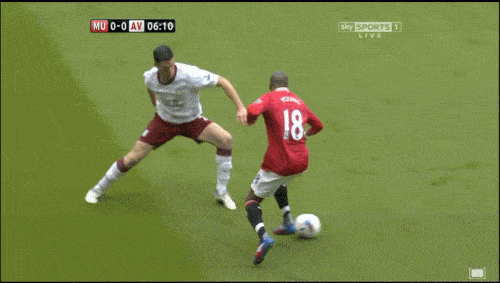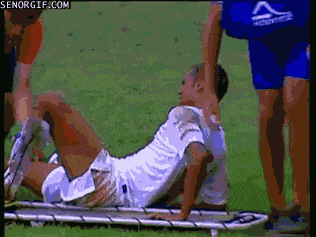Soccer players are known to fake injuries when they are contacted by another player. It has now become part of the game to gain an advantage with a free or penalty kick. However, why do soccer players fake these injuries?
Soccer players fake injuries to gain a competitive advantage. Faking an injury helps to convince the referee that the defender committed a penalty. Faking an injury also helps slow the pace of the game and adds more stoppage time.
This article will show you why soccer players fake injuries and flop to gain an advantage.
Faking Injuries In Soccer
Faking injuries, or flopping as it’s otherwise known in soccer, is an over-exaggeration of contact from a defender to draw a penalty from the referee.

The flop, as shown above, is done by any player on the field who is trying to influence the referee to call a penalty on the defense. The referee may not see the contact due to a poor angle on the play and may believe the player is actually committing the penalty.
In reality, little contact was made, and it was exaggerated by the offensive player, ultimately tricking the referee.
Faking injuries and flopping is frequent in soccer; to get a player eliminated from the game is 2 yellow cards (equaling a red card).
Why Fake Injuries In Soccer?
Faking injuries and flopping can prove to have benefits such as:
- Convincing the referee the defense committed a foul
- Slowing the game down
- Being granted a penalty kick
Flopping is most beneficial when trying to convince a referee that a foul has been committed, when in fact, it wasn’t. It’s a form of trickery that has a tremendous impact on the game.
Slowing the game down is another reason for flopping. As players fall to the ground in soccer, they will lay there until they’re either carried off the field or a stretcher takes them off.
Players can be seen hopping off the stretcher and re-entering the game as if nothing happened. This helps extend the game, adding more time to stoppage time.

If players are exhausted from extreme heat, flopping can be used to get tired or out of breath.
Examples Of Fake Flopping Injuries In Soccer
Oftentimes, the most common injury to fake is the ankle or shin contact. Soccer players will flop and grab the body part contacted the most ( or barely contacted).
If a slide tackle occurs, the ankle or shin will be the first point of contact. Soccer players are often seen holding their ankle or shin as if it’s broken. Wincing in pain and rolling back and forth can really sell as if the ankle is really broken.
Another example is players trying to compete for a header. If two players jump in the air and try to headbutt the ball, soccer players will try to fake as if they got headbutted by the opposing player.
Faking a headbutt typically requires players to fall and grab their faces as if they’ve been violently cut.
See Our Complete List Of Helpful Soccer Articles Here.
Why Soccer Players Flop
We do not recommend flopping in soccer or faking injuries; it does take away from the game’s authenticity. Although it does have some strategic benefits, we recommend limiting how often you flop.
However, if you are looking to gain a strategic advantage from flopping, there are a few things to keep in mind:
- Flopping inside of the box rewards a penalty kick. If you get tripped or slide tackled in the box, there’s a legit reason to flop or over-exaggerate contact.
- If you receiver forcible contact on a body part, it’s in your best interest to sell like it did hurt, if it didn’t then get up and get back on defense.
- Do not make flopping or faking injuries a habit. Faking an injury too often will get you no calls from the referees. Flopping should be used in strategic situations, not throughout the game.
Best Time To Flop During A Soccer Game
We don’t recommend flopping at any point in the game.
Players will often flop when they are inside the box to draw a penalty kick from the referees. Also, when the ball is close to free-kick ( to shoot on the net) territory, players may flop to give their team the opportunity good field position and a chance at a goal.
It can also prove beneficial when playing defense deep in your own territory. Faking an injury can prove to get the ball back against the striking team. It can also be extremely damaging, as faking an injury or flopping could leave a player with a wide-open shot. Aggressive players are often the best to flop against.
As mentioned, we do not recommend you spend time practicing or flopping, as it does ruin the authenticity of soccer. It creates unfair advantages, and referees start to second guess, leading to missing calls.
We mention it in this article because it has become a part of the game, similar to how flopping has become part of the game of basketball. Understanding how to flop properly can help increase your chances of getting a call to go your way.
Conclusion
Although we don’t recommend that anyone practices flopping, it’s no secret that it has become a large part of the game. We always recommend players play as hard as possible within the rules, and good things will happen.
Flopping is often frowned upon as a cheap tactic, and players will often be exposed by the referees if they flop and don’t get the call. This is why we recommend not trying to show up to the referees by faking an injury to get a call.
Play hard and don’t put the game in the referee’s hands. Forcing the referee to make a decision could work in your favor, or it could work against you.
